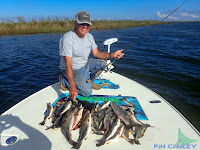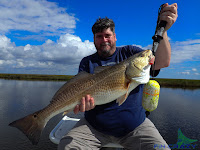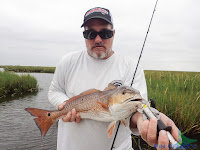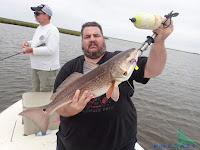
 2015 has been a phenomenal year fishing for me, from traveling across the country fishing a freshwater kayak series to stepping into the IFA redfish tour Boat division to running more charters than I have ever imagined, it's been amazing.
2015 has been a phenomenal year fishing for me, from traveling across the country fishing a freshwater kayak series to stepping into the IFA redfish tour Boat division to running more charters than I have ever imagined, it's been amazing.

 As I sit here watching it rain and listening to the clock tick ever so slowly in anticipation of the LSU vs Alabama game tonight at 7pm, I can't help but think of how I have let my blog slowly decrease in activity over
As I sit here watching it rain and listening to the clock tick ever so slowly in anticipation of the LSU vs Alabama game tonight at 7pm, I can't help but think of how I have let my blog slowly decrease in activity over  the past several months. For a couple years now I have worked hard to build an audience and an avenue where I could share my experiences, successes, and failures, and to those that follow my reports, I apologize. So today is the day where I get back on track and refocus on doing what I love, sharing the outdoors with anyone and everyone that's willing to listen or read about it.
the past several months. For a couple years now I have worked hard to build an audience and an avenue where I could share my experiences, successes, and failures, and to those that follow my reports, I apologize. So today is the day where I get back on track and refocus on doing what I love, sharing the outdoors with anyone and everyone that's willing to listen or read about it.

 Lately our waters have been in a constant change in south Louisiana. One day the waters in Delacroix are 4 feet low and the next they are 4 feet above normal and there is water
Lately our waters have been in a constant change in south Louisiana. One day the waters in Delacroix are 4 feet low and the next they are 4 feet above normal and there is water  running over the highway. Situations like this can present a boat yard of pinballs throughout the marsh bouncing around like crazy hitting every
running over the highway. Situations like this can present a boat yard of pinballs throughout the marsh bouncing around like crazy hitting every  bumper they can in an attempt to catch fish. The sight fishing guys get bummed because now there are 24 foot bay boats sitting in the middle of their shallow water hotspot popping corks in waters that they normally can't get in, the duck hunters are bummed because its 80 degrees out when it should be 50 or 60, and the marsh is so flooded the ducks have endless opportunities to eat and hide in newly formed flooded ponds, and the kayak guys get challenged by the rate of speed the water is falling and 10 paddle strokes now equals only a few feet of travel at times. With all this change that can drive anglers insane, there is always one thing that is constant, fish need to eat.
bumper they can in an attempt to catch fish. The sight fishing guys get bummed because now there are 24 foot bay boats sitting in the middle of their shallow water hotspot popping corks in waters that they normally can't get in, the duck hunters are bummed because its 80 degrees out when it should be 50 or 60, and the marsh is so flooded the ducks have endless opportunities to eat and hide in newly formed flooded ponds, and the kayak guys get challenged by the rate of speed the water is falling and 10 paddle strokes now equals only a few feet of travel at times. With all this change that can drive anglers insane, there is always one thing that is constant, fish need to eat. While we can't always pick the best days to hit the water, like when the sun is shining, the pressure is low, and the tide is at 1.2 feet and falling, it's up to us to adapt to what's going on. I won't ever pretend to know everything outdoors, and while it seems my mind is fading more and more with every year of age I endure, I have learned a few things over the years that have helped me continually fill the box in tough times and in times that matter.
While we can't always pick the best days to hit the water, like when the sun is shining, the pressure is low, and the tide is at 1.2 feet and falling, it's up to us to adapt to what's going on. I won't ever pretend to know everything outdoors, and while it seems my mind is fading more and more with every year of age I endure, I have learned a few things over the years that have helped me continually fill the box in tough times and in times that matter.

Right now the trout are moving in, or for a better term, have moved in. Over the past week, myself and my clients have landed trout from 10 inches to 23 inches with several pushing the 5 to 6 lbs mark. We have caught them in 18 inches of water while sight fishing reds, and in 30 feet of water jigging plastics. We have pulled reds from deep in the grass chasing shrimp in just a couple of inches of water to drop shotting plastics and dead shrimp in 20 feet of water. The patterns haven't held for days on end, one day it's shallow, one day its points, one day is channel bends, one day it's deep holes or choke points. But that's what's great about fall fishing, the fish seem to be everywhere, and while I am confident that some scientist somewhere can break down exactly why and when our fish do what they do, I have always found that trial and error produce more consistent results through sticking and moving rather than sticking to a plan that you read about somewhere.

 Here are a few of the steps that I have been walking lately that have kept the box full whether the sun was shining or the rain was falling, both in shallow water and high.
Here are a few of the steps that I have been walking lately that have kept the box full whether the sun was shining or the rain was falling, both in shallow water and high.
 If the water is extremely high and the tide is falling out fast, go deep for trout and reds in a man channel with a drop shot set up. A main channel being one that the marsh is draining into and then it is draining into an even bigger channel. I don't mean just roll up into Bayou terre aux boeuf and start slinging drop shots, but as a point of reference, bayou terre aux bouf would be considered the "bigger channel" . Try a couple spots like this and find what works, if that's not working move shallow, find some drains that are filtering out of the marsh itself, these would be small cuts that you wouldn't dare put your boat into, but if the current is falling out of it from the endless grassy marshes around, try the mouths of them. Don't just hit one and give up, hit 5 or 6 of them and when you find one producing, work it until it stops producing, move on to another, and then circle on back again and see if it has become active again. There are days when I may stop at 15 different locations and only 3 of them produce, but they continue to produce all day long if you keep giving them a break to explore other areas.
If the water is extremely high and the tide is falling out fast, go deep for trout and reds in a man channel with a drop shot set up. A main channel being one that the marsh is draining into and then it is draining into an even bigger channel. I don't mean just roll up into Bayou terre aux boeuf and start slinging drop shots, but as a point of reference, bayou terre aux bouf would be considered the "bigger channel" . Try a couple spots like this and find what works, if that's not working move shallow, find some drains that are filtering out of the marsh itself, these would be small cuts that you wouldn't dare put your boat into, but if the current is falling out of it from the endless grassy marshes around, try the mouths of them. Don't just hit one and give up, hit 5 or 6 of them and when you find one producing, work it until it stops producing, move on to another, and then circle on back again and see if it has become active again. There are days when I may stop at 15 different locations and only 3 of them produce, but they continue to produce all day long if you keep giving them a break to explore other areas. 
 If you want to move on from the marsh and go into really deep water to try your luck, the most consistent thing I've seen lately is that the bottom is golden. If your lure isn't reaching the bottom, odds of you being out fished
If you want to move on from the marsh and go into really deep water to try your luck, the most consistent thing I've seen lately is that the bottom is golden. If your lure isn't reaching the bottom, odds of you being out fished 


 are 10 fold. I watched a client this past week catch trout off the back of the boat 7 to one to her partner on the front of the boat. It wasn't the location or a special reef she was fishing, the only difference in the presentation was that she let her lure get all the way to the bottom. When going deep this week, you have to learn patience, not necessarily patience for the bite, but that 10 to 12 seconds of stagnant time anxiously awaiting your lure to reach the strike zone. It's a great time to hit your reels
are 10 fold. I watched a client this past week catch trout off the back of the boat 7 to one to her partner on the front of the boat. It wasn't the location or a special reef she was fishing, the only difference in the presentation was that she let her lure get all the way to the bottom. When going deep this week, you have to learn patience, not necessarily patience for the bite, but that 10 to 12 seconds of stagnant time anxiously awaiting your lure to reach the strike zone. It's a great time to hit your reels  with a little lubrication, Reel Magic or whatever you normally use to keep your equipment in top shape.
with a little lubrication, Reel Magic or whatever you normally use to keep your equipment in top shape. While the sight fishing game is still going on as our waters continue to clear up, keep in mind it is duck season and most ducks fly early and get shot
While the sight fishing game is still going on as our waters continue to clear up, keep in mind it is duck season and most ducks fly early and get shot
 at early, so if you're headed to the shallow ponds, let the sun get high, redfish will bite all day. With a short season on big ducks, let those guys have their fun, and you can come in later in the day and have yours.
at early, so if you're headed to the shallow ponds, let the sun get high, redfish will bite all day. With a short season on big ducks, let those guys have their fun, and you can come in later in the day and have yours.I hope some of this is useful for you and helps in putting together a plan that will help you land more fish, but at the same time encourage you to step out of your normal comfort zone and find new areas to fish, and new techniques to use during high water tides.
As the water begins to recede following all of east winds that have flooded our marshes, I'll follow this up with some shallow water tactics based on
what's happening out there as we get into a normal fall/winter water level or pattern.
Until Next Time,
Good luck, Stay Safe, & Catch1